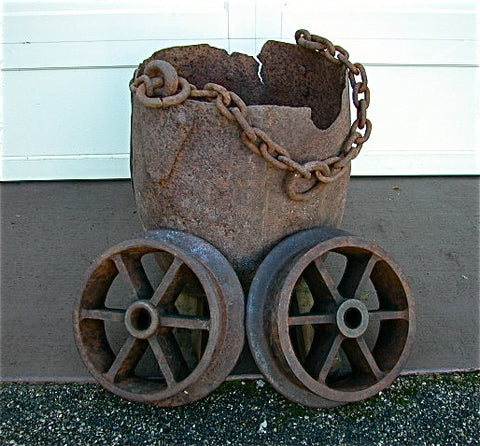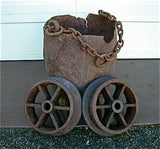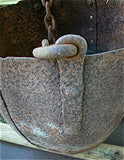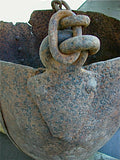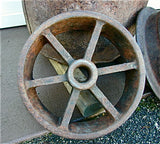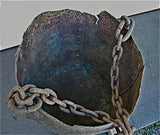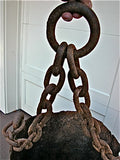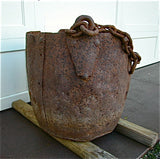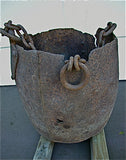Kibble and Tram Wheels, Petherick Mine, Copper Falls Mining Company, Lake Superior Copper District, Keweenaw County, Michigan - PENDING DONATION TO A. E. SEAMAN MUSEUM
NSMWminart1
Kibbles are the Cornish mining term for iron buckets used to remove ore and waste rock from mines. Kibbles were employed for centuries in European mines and their general design adopted for manufacture in the U.S. mainly by immigrant Cornish engineers and miners who were invaluable in the developmental stage of mining for metal ores. It is important to note that any manufactured mining tool made of iron was critically important and valuable in these very early years of mining, particularly so in the more remote districts like the Copper Country in the 1840s. Mining equipment was employed to the last ounce of usefulness and then repaired, or perhaps re-tooled for another job. This kibble shows all the hallmarks of a well used and invaluable piece of equipment from the mid-1800s. Note the different clasps on either side of the bucket that fix the chain to the kibble: one is a narrow band or strap with rivets and the other a much wider, triangular shaped clasp. The explanation being the original clasp failed at some point and pulled off the edge. Since the kibble was so critical for mining in this isolated frontier, it was replaced on site by a blacksmith. The repair was like a bandage where the new clasp overlapped the old riveted band and was spliced on with new rivets to cover a wider area, thus increasing integrity. The hand forged chain is all completely intact with a center ring for pulling or hoisting the bucket up stopes or shafts. On the bottom of the kibble is another ring: a rope was latched here and the kibble raised on end to dump the ore and rock into a tram car. The tram car was then pushed or hoisted out of the mine. It is quite likely this kibble was employed in mines nearby that were owned or operated by the Copper Falls Company, for instance, the original Copper Falls Mine discovered in 1844 or perhaps the Hill Mine that operated in the vicinity in the 1850s.
There are other old kibbles from other areas that show up for sale on the market but many are either missing parts, completely rusted through, re-painted or altered in some manner and with locations that may simply list a mining area, general district or perhaps only a state.
The provenance for this artifact is as good as it gets: it was collected by me and a friend about 30 years ago while we were underground on the 2nd Level of the Ashbed Lode in the Petherick Mine. The Petherick Mine operated two orebodies, namely, the Copper Falls Fissure (a vein-type orebody with mass copper), and the Ashbed Lode (an amygdaloidal type orebody conformable with regional igneous and sedimentary beds). Since the kibble was found on the 2nd Level of the Ashbed Lode near stopes it was likely being used at that time and place to assist in driving the drift or perhaps mucking out stopes.
The tram car wheels were collected from an old wooden mining car in the Ashbed Lode as well but between the 1st and 2nd levels stopes. They are incredibly heavy, durable wheels and foundry-made so I suspect may have been ordered by the Copper Falls Company from a manufacturer on the East Coast or perhaps even in England and then transported by ship to the Copper Country. They are of the same vintage. c.1850s.
These are exceedingly rare and important artifacts from the very, very early days of mining in the famous Lake Superior Copper District. It is remarkable that they survived intact.
Kibble dimensions: 2 feet across and just over 2 feet vertical: weight about 200 pounds. Tram wheels have 19 inch diameter and weigh approximately 90-100 pounds.
There are other old kibbles from other areas that show up for sale on the market but many are either missing parts, completely rusted through, re-painted or altered in some manner and with locations that may simply list a mining area, general district or perhaps only a state.
The provenance for this artifact is as good as it gets: it was collected by me and a friend about 30 years ago while we were underground on the 2nd Level of the Ashbed Lode in the Petherick Mine. The Petherick Mine operated two orebodies, namely, the Copper Falls Fissure (a vein-type orebody with mass copper), and the Ashbed Lode (an amygdaloidal type orebody conformable with regional igneous and sedimentary beds). Since the kibble was found on the 2nd Level of the Ashbed Lode near stopes it was likely being used at that time and place to assist in driving the drift or perhaps mucking out stopes.
The tram car wheels were collected from an old wooden mining car in the Ashbed Lode as well but between the 1st and 2nd levels stopes. They are incredibly heavy, durable wheels and foundry-made so I suspect may have been ordered by the Copper Falls Company from a manufacturer on the East Coast or perhaps even in England and then transported by ship to the Copper Country. They are of the same vintage. c.1850s.
These are exceedingly rare and important artifacts from the very, very early days of mining in the famous Lake Superior Copper District. It is remarkable that they survived intact.
Kibble dimensions: 2 feet across and just over 2 feet vertical: weight about 200 pounds. Tram wheels have 19 inch diameter and weigh approximately 90-100 pounds.

